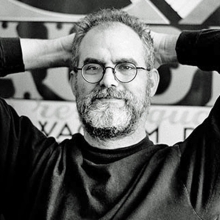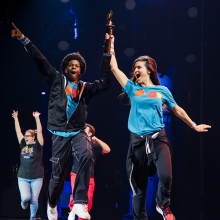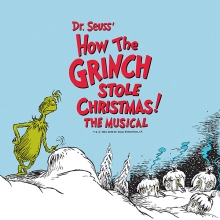CANDIDE & WEST SIDE STORY: Opera? Operetta? Musical? What Do You Say?
CANDIDE & WEST SIDE STORY: Opera? Operetta? Musical? What Do You Say?
By Kathryn Harris on August 25, 2009
in
Show/Author Spotlight
| Tags:
Leonard Bernstein, Show Spotlight
by Yui Kitamura
Bernstein working on WEST SIDE STORY with lyricist Stephen Sondheim
August 25th marks composer Leonard Bernstein's birthday. Born in 1918, this prolific artist created a wide variety of music until he died in 1990 at the age of 72. Bernstein was a great educator, conductor, and music director, as well as a composer of classical, film, and theatre music.
Of the many famous theatre works that Leonard Bernstein wrote with his collaborators, CANDIDE and WEST SIDE STORY still remain immensely popular. New York City Opera recently did a production of CANDIDE in the spring season and WEST SIDE STORY came back to Broadway early this year.
Musical theatre, opera and operetta almost always include both words and music. The difference among them is how music contributes to the structure and plot of the story. There is no question that CANDIDE and WEST SIDE STORY are both theatrical works where music plays a big role in storytelling. However, CANDIDE is often considered an operetta and WEST SIDE STORY is considered a musical, even though the same composer wrote the music to both shows.
The story of WEST SIDE STORY is based on the play, Romeo and Juliet by William Shakespeare. There are two groups of characters: a bunch of young Puerto Ricans who live in New York's Upper West Side, and a group of young Americans who live in the same area. CANDIDE, on the other hand, is set in Europe in the 18th century. Regardless of the language in which the script is written, when and where the story is set greatly affects the musical atmosphere. In most cases, music composed to stories set in Europe sounds different from the music of stories set in the Americas. That is because when composers write music that describes the characters' lives in a specific time or location, they study the culture and imagine that they are in the story themselves so that they can write something that describes the characters' lives most effectively. In WEST SIDE STORY, Bernstein and his writing collaborators planned the dance music to be as equally important as the words and songs in order to move the plot forward.
The Dance at the Gym from the original production of WEST SIDE STORY
Because movement plays a major role in the storytelling of this piece, WEST SIDE STORY needs performers who can dance, act and sing well. Bernstein's dance score for this piece challenges the choreographers to express the anger, hatred, frustration, energy, and other strong emotions of the characters through dance movements.
We call a performer who sings in musical theatre an actor or a singer, but rarely call an opera singer an actor. This results in an obvious difference in casting. Actors or singers in musicals usually physically resemble the characters they are playing. While costumes add to the level of realism, actors still rely on skills to imitate the movements and vocal inflections of their characters.
While the music and story of CANDIDE do not rely on dance, the piece challenges singers in different ways. The vocal writing of this piece is more operatic than that of standard Broadway musicals. The vocal range for each character is expansive, and goes up higher than a normal speaking voice. Additionally, classical techniques are often called for in the score. For example, there are many places where singers have to leap up to a high note (like soprano's high C) and drop back down to another voice range instantly, and melismas (many notes are sung while sustaining a syllable) are used often. In order to make those hard vocal lines come out the way they should, singers cannot have fast body movements and must make sure they are facing the audience so that their vocal timbres stay the same. In operas, it really does not matter if the character whose description is "handsome" is actually handsome so long as the singer's voice is spectacular. The singers' looks are not that important once we move several scenes into the opera. Even an old chubby lady playing the heroine who is supposed to be the most beautiful girl in the world succeeds in convincing the audience by expressing the character's emotions through her voice.
Instrumentation also flavors the audience's perceptions when determining if something is musical theatre or classical opera (operetta). All of the instruments that Bernstein used in the original production of WEST SIDE STORY were acoustic except for an electric guitar. Even though the score does not call for amplified instruments like electric bass or digital sound samples, use of the saxophones and drum set makes it very American since those instruments are not usually used in traditional European symphonic works. Those instruments are used in a big band or in jazz ensembles that present the styles of music born in America.
The instrumentation of CANDIDE is more akin to classical music. Even though it calls for an electric keyboard, the sounds the keyboard player is asked to use are celeste, chime, harpsichord, lute, organ, and piano - instruments associated with classical music.
No matter what genre we use to classify these two works, both use unique sounds and sites to transport audiences to unique moments in history. This is a testament to Leonard Bernstein's genius and accessibility.

Lauren Worsham, Judith Blazer and Daniel Reichard in New York City Opera's CANDIDE--photo from playbill.com
Check out MTI's WEST SIDE STORY and CANDIDE show pages for more information or to license these shows. To discuss this article or to share your thoughts on these shows, visit the WEST SIDE STORY and CANDIDE MTI ShowSpace pages.
























